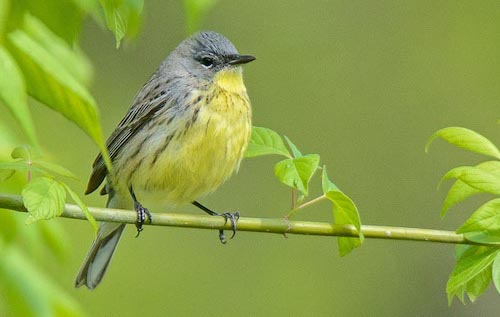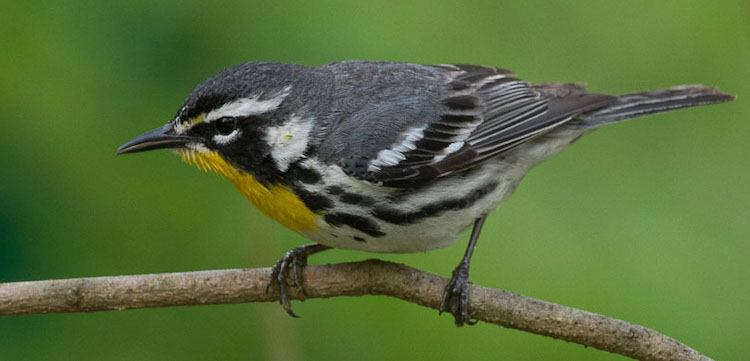By Chris Lotz CEO of Birding Ecotours
I’ve written a few articles here on Fatbirder before, about the excitement of Year Birding in Ohio. Now that I’m almost midway through my third year heading up the Birding Ecotours office here in Columbus, central Ohio, I’ve learned a lot more than I knew when I wrote the previous articles. Two years of practice has been very helpful, and by the end of May this year I found myself sitting on 268 species. Is it possible for me to see 300 bird species in Ohio this year?

2019 was a historic year for Kirtland’s Warblers migrating through Ohio en route to their breeding grounds (largely in Michigan). But I missed all of them as I was away in South Africa. Maybe I’ll see one in the Fall? Photo by ©Dom Rollinson
Getting the remaining 32 species will be a challenge though, for two main reasons.
Firstly, I travel abroad a great deal. I’m absent from Ohio during some of the peak migration periods. For example, this last April was an incredible month for rarities. But I wasn’t here. I was in South Africa for almost the month.
Secondly, when I am here in Ohio, I have to work. Sometimes I find that I can’t chase a rarity even when it’s only an hour and a half away. (From an American perspective, a short drive like that in this huge country is nothing, but it eats into my working day.) Worse, birds often pitch up two and a half hours away. For example, Lake Erie attracts lots of rarities but is over two hours away. While Columbus’ position in central Ohio is good for state twitching (and twitching, or chasing as it’s called here, is essential for anyone trying to reach 300 in a year within Ohio), it’s not always good enough; the furthest corner of the state (Conneaut in Northeast Ohio near Pennsylvania and New York) is still three and a half hours away (although at least it’s not a four and a half hour drive away like it is for the poor folks in Dayton.)
I was only in Ohio for the first nine days of January, but during those nine days I tried my very best to get a ‘January 100’. That’s what many serious Ohion birders like to do, as a really fun ‘game’ – to see 100 bird species during the worst winter month. I actually managed to get to 90 species by January 9th before heading to Sri Lanka for a birding trip there. The so-called ‘pelagic’ on Lake Erie helped, with some good species such as scoters, Iceland Gull, etc. Immediately after Sri Lanka, I headed to South Africa, and effectively only found myself returning to Ohio in March, by which time most Ohio year birders (of which there are many!) were way ahead of my 90 species.
When I’m actually in Ohio, I bird hard though. So, I soon managed to get back into seventh place on the e-bird ‘Top 100’ for Ohio in 2019. The real disaster came when I spent virtually the whole of April, and the first few days of May, in South Africa again – touring places like the Kruger National Park.

Yellow-throated Warbler I finally caught up with in mid-May, later than most birders. Photo by ©Dom Rollinson
My advice to birders trying to be competitive in Ohio is as follows: don’t miss any of the spring migration, as it will be damaging to your attempts to be a competitive state lister! EEK! Not only did I miss all the normal species that were coming in (which would make May a completely frantic and mad month of birding for me, playing catch up and all), but I also missed more vagrants than I care to mention here.
Usually folks get the southern Ohio species such as Worm-eating Warbler, the stunning Cerulean Warbler, Louisiana Waterthrush, Yellow-breasted Chat, Broad-winged Hawk, etc., at the very end of April. As a by-product of finding all these specials, they also get well ahead with the common migrants such as many of the other dazzling wood-warbler species. But, since I wasn’t here in April, I instead had to work like crazy to get all these common species in May, along with trying to chase rarities, and then I left the southern Ohio birds right until the end of May, which no one else does around here.
I’d been told I needed to get to 250 species by the end of May to have any chance of getting to 300 by year-end, and somehow (basically with frantic birding) I actually exceeded this and made it to 268 species! (And, again, I found myself in seventh place on the e-bird Top 100 for Ohio this year). The problem though is that even 268 simply doesn’t seem good enough when I try to strategize about how to get to 300 by year-end.

Black-throated Green Warbler (©Dylan Vasapolli) is one of the most common migrants through Ohio in May. One of them turned into a TOWNSEND’S WARBLER!
Ohio birds are coded 1-6, with only code 1-3 birds probable in a ‘Big Year’, and code 5-6 birds rather unlikely (to say the least). Code 4 birds are, of course, in the middle – tough, but one should get a fair number of them. Now as I write this at the start of June, I only have 15 species I should probably see, which means I need 17 vagrants. Can I get 2-3 vagrants each month for the next 7 months? That’s what I need, but I’m off to northern Norway (Svalbard) for most of the rest of June, then in September and late October into early November I’ll be in South Africa and Bolivia, respectively. Those are peak migration periods.
Well, we’ll see. Finding the remaining 32 species will be very tough, and not very likely, but who knows? Check for my next article in a couple of months’ time!
Just a couple of further thoughts about May, which is the best and most productive birding month in Ohio. Because I simply didn’t have time to chase everything, I missed Connecticut Warbler, Kirtland’s Warbler and a late Eared Grebe (in breeding plumage). With lots of luck, I can still catch up on these species during Fall migration or in the latter case, winter. I did manage to see two MEGA rarities for the state, Townsend’s Warbler (normally a western species) and Swainson’s Warbler (typically a southern species). Hooray for those!
You may ask, “Is it all worth it?”
You must be kidding.
How can you even ask that question?
Of course, YES is the answer! Trying to see 300 bird species in Ohio in a single year is incredible fun and hugely recommended in its own right.
Firstly, one gets to know the bird species better than one would if one just wanted to try and see them once somewhere (aiming to see them every year, within the state of Ohio, forces a birder to get to know the habits, habitats, ID features, etc. of each bird better).
Secondly, it’s my excuse to get to know Ohio well. I’ve seen a large proportion of the 88 counties of this state (but have stopped myself from getting into another ‘game’ birders play here – to e-bird in every county!). And, I’ve been on a myriad country roads, always trying to get one more species for my year list.
And wherever one goes, one meets not only one’s avian friends, but also human friends. Chasing rarities is an immensely social thing to do here in Ohio.
The mammals are the true prize for me though. After seeing a really good mammal, that often becomes the best ‘bird’ of the trip for me. For example, when I chased a Little Gull last year, it was a beaut, but the Beaver that swam right past me, showing well, was even more memorable. When I tried in vain for a vagrant Painted Bunting in May this year, I saw, for the first time, some Woodchucks trying to sleep in their burrows – while this is a common animal in Ohio (and one of my favourites), I had never seen them in their burrows until I tried for the Painted Bunting; usually one sees them standing up on the surface peering around.
I occasionally see Coyotes, but the best experience I’ve had in Ohio with a mammal (while trying to work on my Ohio year list), was seeing a close-up Bobcat that crossed the road in front of us and then stopped to allow binocular views, before vanishing into the forest! This was when a couple of us were trying to find Ruffed Grouse in extreme southern Ohio. We didn’t find the grouse, but we found something even better!
I plan to write an update within the next few weeks. Do you think I’ll be able to move from 268 to 300 species in Ohio before the end of 2019?
